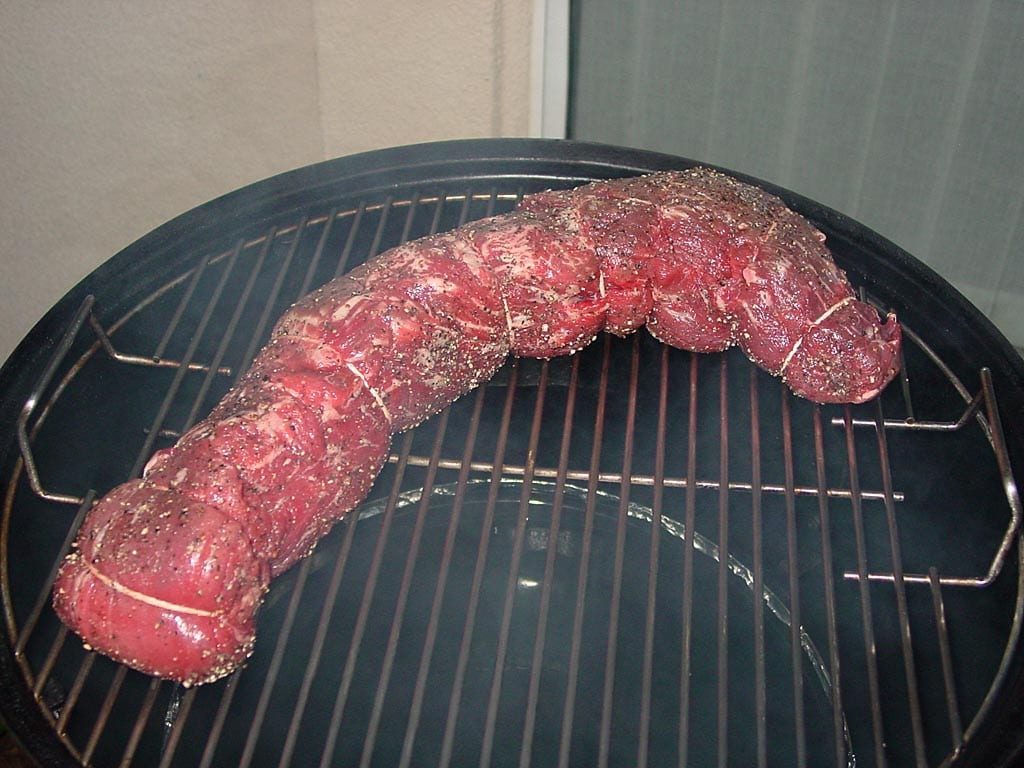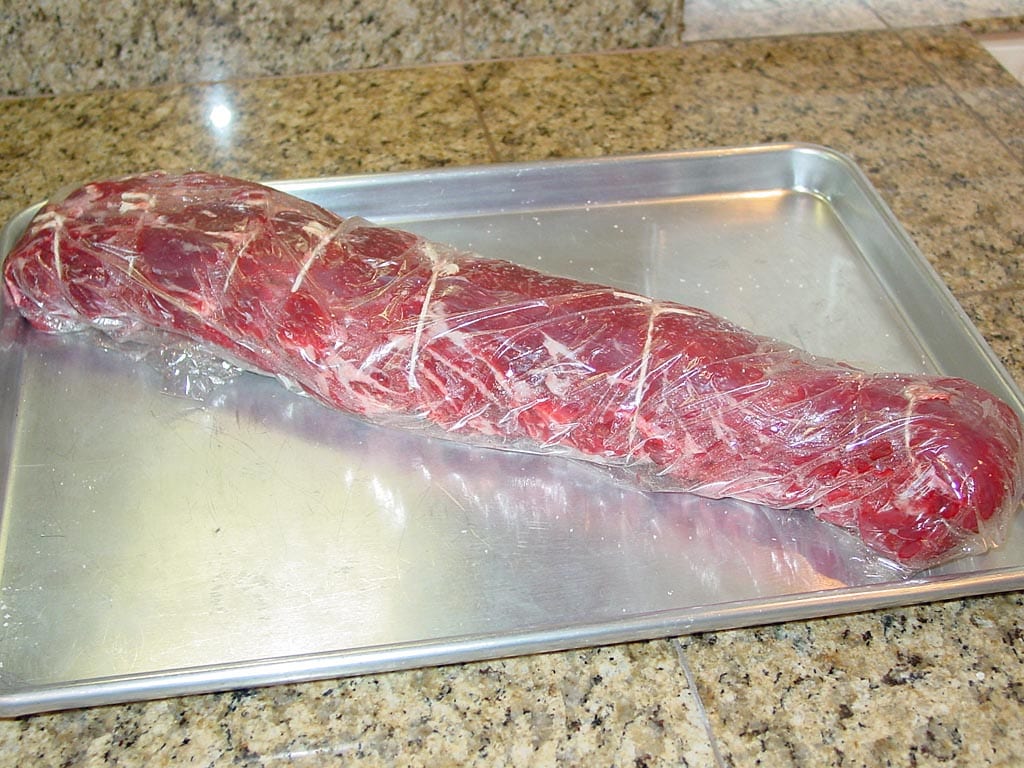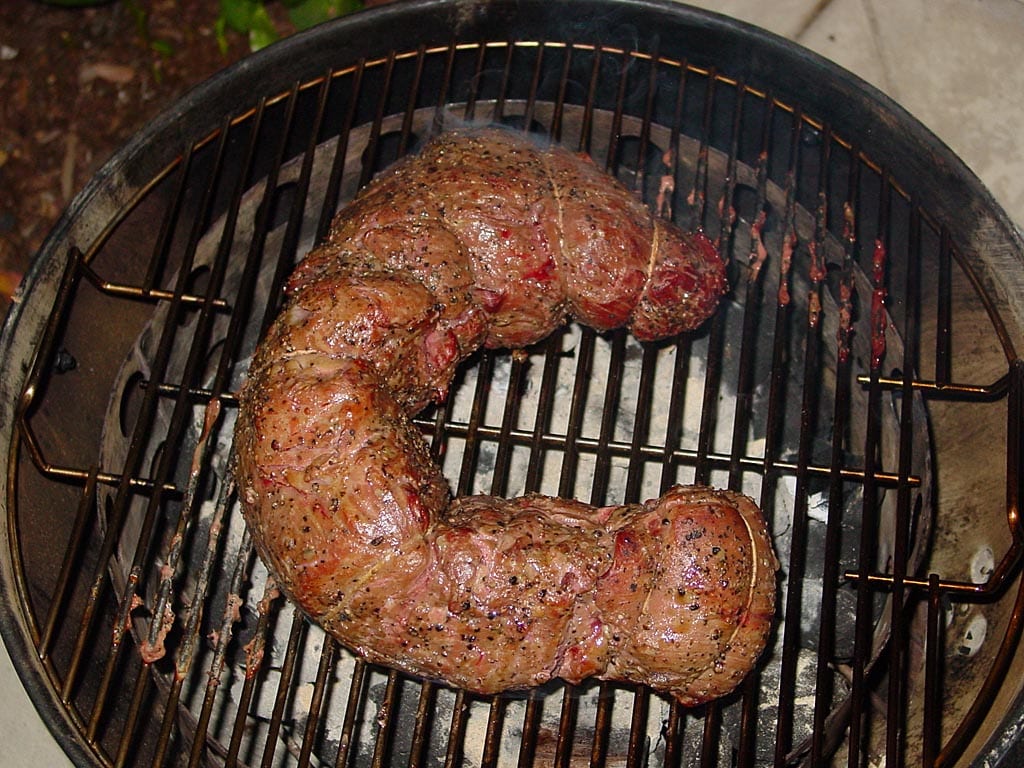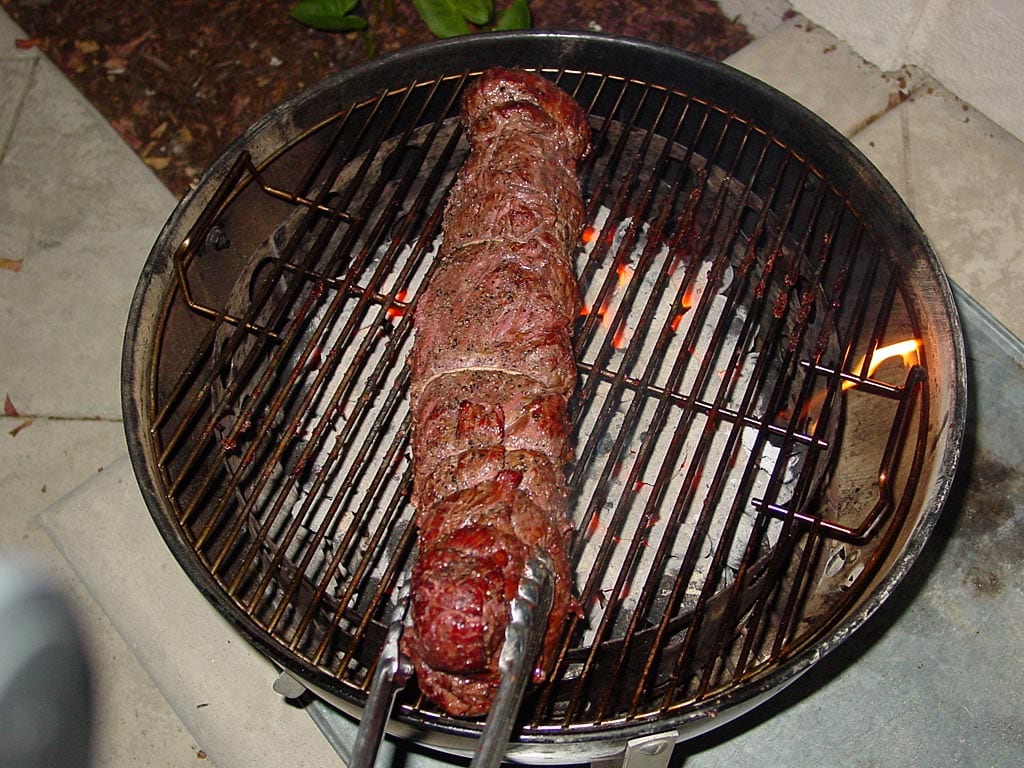How Do You Grill a Beef Tenderloin on a Weber Gas Grill
Summary
- Buy a 5-half-dozen pound whole beef tenderloin.
- Carefully remove most of the fat, the "chain", and all membrane and silverskin.
- Fold nether 2″ of the sparse cease for fifty-fifty thickness, then tie the roast in 7-8 locations.
- Sprinkle with kosher salt, wrap in plastic wrap, and let sit down at room temperature for one 60 minutes.
- Simply before cooking, employ a sparse coat of olive oil and sprinkle with freshly croaky black pepper.
- Smoke at 225-250°F until 120-125°F for rare/medium-rare or 130-135°F for medium-rare/medium, approximately 55-65 minutes.
- Place cooking grate directly over hot coals. Sear tenderloin on all four sides, approximately ii minutes per side.
- Comprehend loosely with foil and let rest for 10 minutes before slicing.
 The whole beef tenderloin roast is sometimes called a "whole filet", a "filet mignon roast", or a "tenderloin tip roast". It is a long, tapered muscle located on the inside of the short loin, extending from the 13th rib to the pelvis.
The whole beef tenderloin roast is sometimes called a "whole filet", a "filet mignon roast", or a "tenderloin tip roast". It is a long, tapered muscle located on the inside of the short loin, extending from the 13th rib to the pelvis.
A whole tenderloin has three distinct areas:
- The large end, chosen the barrel end. It actually resides in the sirloin section.
- The small-scale finish, called the tail.
- The center section, called the eye.
The tail is commonly folded under the middle department and tied to create even thickness for even cooking.
Beef tenderloin is the most expensive and near tender cut of beef, but information technology likewise has a reputation for balmy sense of taste considering it does non contain a lot of intramuscular fat. Fortunately, with some conscientious trimming and a lilliputian chip of salt, pepper, and smoke, you tin transform this cut into something really special for the holidays or any solar day!
Here's a description and photos of how I cooked a whole beef tenderloin on November xix, 2005. Exist sure to check-out the accompanying video for a quick overview of how to prep the meat for cooking.
Select And Prepare The Tenderloin

Cull a 5-half-dozen pound, USDA Choice whole beef tenderloin. This cut of meat will cost a ton of money if you purchase it from a skillful butcher fully trimmed and tied. If yous want to save up to 50% and are willing to spend xx-30 minutes trimming and tying the meat yourself, then buy a whole tenderloin in Cryovac packaging at a wholesale warehouse store.
I bought the USDA Choice whole tenderloin pictured here at Costco. The photograph above shows the tenderloin after I trimmed and tied it. It weighed 5.60 pounds before trimming.
If you lot desire to try your hand at trimming and tying a whole tenderloin, I would propose that you do it the night earlier. This gives you plenty of fourth dimension to work with the meat without feeling rushed.
You will need the following tools:
- A very precipitous boning pocketknife
- Kitchen twine
Here are the steps for trimming the roast. Accept your time—remember, this is an expensive cut of meat, and you want to remove the waste without losing much of the valuable meat.
- Remove the meat from the Cryovac packaging and pat dry with paper towels.
- Using your fingers, pull off as much loose fat and membrane equally possible from both sides of the roast.
- Remove the side strap or chain, a length of sinewy musculus and fat attached to ane side of the tenderloin. Information technology volition come up off in a unmarried slice and can be pulled off by hand, but don't be afraid to utilise a pocketknife, if necessary. Pull off or trim any areas of fatty or membrane exposed as a result of removing the concatenation.
- On the butt stop, carefully remove the pockets of fat in the two crevices on either side of the tenderloin. Make shallow cuts to remove every bit footling meat as possible in the procedure.
- Remove the silver skin. This is a length of white/silver gristly connective tissue running from the butt end toward the tail. It's tough eating and needs to be removed. Starting somewhere in the centre, shimmy the tip of the knife under the edge of the silverish skin 1/ii″ to 1″, then push the knife tip up through the pare. Angle the blade up slightly and use a sawing motion to cut to the end of the peel. Angling the blade up helps you to remove the peel without losing much meat. Adjacent, grasp the loose terminate of the silver pare and cut to the opposite end using the same blade bending and sawing motion. Remove all the silver skin using this technique.
- Flip over the tenderloin and trim any areas of fat.
- Requite both side of the meat a final visual inspection and clean up any remaining areas of fatty, membrane, or silvery skin.
Here are the steps for tying the roast. Tying is done to create even thickness for even cooking and to secure any floppy bits of meat. For a lesson in tying knots, scout the How To Tie A Roast video.
- Pre-cutting 7-8 pieces of kitchen twine, each about 18″ long.
- Fold about 2″ of the tail nether the middle department to create an even diameter. Tie in ii spots to secure.
- Tie the butt end in 3-4 spots to secure the meat.
- Tie the eye section in 2-3 spots.
- Trim the loose ends of the twine.
Wrap the tied tenderloin in plastic wrap and refrigerate overnight.
The next day, remove the tenderloin from the refrigerator 1 hour before cooking it. Pat dry with newspaper towels.
Sprinkle all sides with one-one/2 Tablespoons of kosher salt. Wrap in plastic wrap and let sit at room temperature for one hour. This step allows the salt to penetrate the meat and will assistance it cook more than evenly.
Just before cooking, utilise a sparse glaze of olive oil and sprinkle with a adept amount of freshly cracked black pepper.
Video: Preparing A Whole Beef Tenderloin
This video demonstrates the process of preparing a whole beef tenderloin for cooking. Click on the video to play.
Fire The WSM
Fire-up the cooker using the Minion Method. Fill the charcoal bedchamber 1/2 to 3/4 full with unlit Kingsford Charcoal Briquets, then low-cal 20-40 briquettes using a Weber chimney starter and place them on top of the unlit ones.
Put the h2o pan in the cooker and fill up it with water to assistance with temperature control.
Smoke The Tenderloin
Place 2-iii minor chunks of dry out smoke wood on the coals. Use a mild wood, and don't use much of information technology. I used three small-scale chunks of apple wood, perchance equivalent to a single fist-sized clamper.
Get together the cooker and identify the tenderloin on the top grate. Set the 3 bottom vents to 100% open. Open up the summit vent fully and get out it that way throughout the unabridged cook.
When the cooker reaches nigh 225°F, set the three lesser vents to 25% open up then the cooker settles in at 225-250°F measured at the lid. Adjust the three bottom vents as necessary to maintain this temperature.
Cook the tenderloin to an internal temperature of 120-125°F for rare/medium-rare or 130-135°F for medium-rare/medium, approximately 55-65 minutes.
In that location's no need to baste or rotate the tenderloin during the cooking process.
Here'south how the cooker temperatures and vent settings went during my cook:
| Time | Lid Temp | Meat Temp | Vent 1 % | Vent two % | Vent 3 % |
| 5:05 pm | – | – | 100 | 100 | 100 |
| v:fifteen pm | 192 | – | 100 | 100 | 100 |
| 5:xx pm | 200 | – | 100 | 100 | 100 |
| 5:30 pm | 212 | – | 100 | 100 | 100 |
| 5:45 pm | 240 | – | 25 | 25 | 25 |
| half dozen:00 pm | 235 | – | 25 | 25 | 25 |
| half dozen:05 pm | 235 | 127-133 | 25 | 25 | 25 |
| 6:x pm | 235 | 130-135 | 25 | 25 | 25 |
Note that the vent percentages represent the way I set the vents at the fourth dimension indicated.
Opposite Sear The Tenderloin

Many recipes call for searing a roast at high temperature at the beginning of the cooking procedure, then reducing the heat and cooking until done. Nonetheless, for the most even doneness within a roast, you want to do the opposite—cook the meat at low temperature until almost washed to your liking, then sear it apace at loftier temperature at the end. This is known as a reverse sear.
Don't skip this searing step, considering it creates lots of great flavor on the surface of the meat.
Remove the elevation cooking grate from the cooker and set it aside. Carefully lift off the heart cooking department (making sure not to spill whatsoever water) and prepare it aside. Utilize tongs to evenly spread out the hot coals in the charcoal chamber, if necessary.
Place the cooking grate directly on peak of the charcoal chamber. Sear the tenderloin on all four sides, approximately two minutes per side or until browned to your liking.
 I seared this tenderloin on two sides by curling it into a c-shape, so seared the other 2 sides by property the meat on edge with tongs.
I seared this tenderloin on two sides by curling it into a c-shape, so seared the other 2 sides by property the meat on edge with tongs.
Residue Then Slice The Tenderloin
Remove the tenderloin from the cooker. Comprehend loosely with foil and allow remainder for 10 minutes before slicing.
Snip the kitchen twine and remove information technology. Slice the meat into one/4″ to 3/8″ slices across the grain.
The photos above testify the seared tenderloin after a x minute rest and the consistent doneness inside the roast. The meat is evenly pink across almost its entire diameter, which is accomplished by using the contrary sear cooking process.
Here's how I described this tenderloin in my cooking log:
- "Fork tender"
- "Skillful moisture"
- "Fabled season"
- "No one at Christmas dinner would be disappointed!"
Sauces For Beef Tenderloin
Beefiness tenderloin has a mild flavour, so it is oft served with a sauce on the side. Your smoked tenderloin will have more season than nigh, and you may find that a sauce is not necessary.
I similar a creamy horseradish sauce with beef, and I'm quite satisfied with the ones I detect at the supermarket, particularly Beaver Cream Style Horseradish.
If y'all'd like to try your paw at making a sauce, hither are some recipes to get you started.
Horseradish Cream Sauce
From Cook's Illustrated mag
- 1/ii loving cup heavy cream
- ane/two cup prepared horseradish
- 1 teaspoon tabular array salt
- 1/8 teaspoon ground black pepper
Whisk the heavy cream for i-two minutes until thickened but not nonetheless holding soft peaks. Fold in horseradish, common salt, and pepper. Transfer to a serving bowl and refrigerate 30-60 minutes before serving.
Sour Foam Horseradish Sauce #1
From Cook'due south State magazine
- 1/2 cup sour cream
- 1/two cup prepared horseradish
- 1-one/2 teaspoons kosher salt
- 1/2 teaspoon ground black pepper
Whisk together all ingredients. Embrace and refrigerate until gear up to serve.
Sour Cream Horseradish Sauce #ii
- 1 loving cup sour cream
- 2 Tablespoons prepared horseradish
- 1 teaspoon lemon zest
- i/2 teaspoon Worcestershire sauce
- ane/4 teaspoon hot pepper sauce
- one/4 teaspoon salt
Whisk together all ingredients. Cover and refrigerate until ready to serve.
Mustard Horseradish Cream Sauce
From Sheila Lukins, Parade Magazine
- i/3 loving cup Dijon mustard
- one/ii cup sour cream
- 1/iv cup prepared mayonnaise
- 1/iv cup well-drained prepared white horseradish
Whisk together all ingredients. Encompass and refrigerate until ready to serve.
Whipped Cream Horseradish Sauce
- 1 loving cup heavy foam, whipped to soft peaks
- Juice of 1/2 lemon
- ane heaping Tablespoon freshly grated horseradish or three Tablespoons prepared horseradish
- Kosher salt and freshly ground black pepper
Stir horseradish and lemon juice into whipped cream. Add together salt and pepper to taste.
Gorgonzola Foam Sauce
- four cups heavy cream
- iii-four ounces crumbly Gorgonzola cheese (not creamy or "dolce")
- 3 Tablespoons freshly grated Parmesan cheese
- 3 Tablespoons minced fresh flat-leaf parsley
- 3/4 teaspoon table salt
- 3/4 teaspoon freshly ground blackness pepper
In a saucepan over medium-loftier heat, bring cream to a full eddy. Eddy rapidly 45-50 minutes until thickened like a white sauce, stirring occasionally. Remove bucket from estrus, add all ingredients. Whisk rapidly until cheeses cook.
To reheat, warm the sauce over low heat until melted, so whisk rapidly until sauce comes together.
Back to Cooking Topics
Source: https://www.virtualweberbullet.com/beef-tenderloin-salt-pepper/
0 Response to "How Do You Grill a Beef Tenderloin on a Weber Gas Grill"
Post a Comment